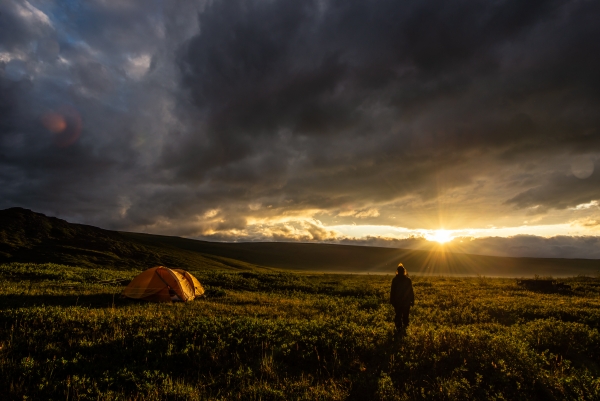
There are no established campgrounds or camping facilities in the refuge.
Tips for backcountry campers:
A few areas of the refuge receive concentrated use, resulting in unwanted trail formation and trampled vegetation. Take the following measures to limit further deterioration and allow impacted areas to heal:
- Camp and walk on durable surfaces (rock, gravel, sand, snow, annually-flooded riverbar, etc.) or on sturdy vegetation when these are available. Wear low-tread shoes in camp, and move your camp location every few days, to avoid vegetation wear and trail formation throughout your camping area.
- If you can see a tent area or faint path from previous use, choose another location. An exception is at aircraft landing sites where practical alternatives do not exist. If there are no durable surfaces at such a spot, it may be wisest to use existing camp sites and trails to keep impacts from spreading.
- Fires, though allowed, are not recommended within the refuge because trees grow very slowly in the far north and wood is scarce in some areas. We recommend using gas stoves for heating and cooking. Visitors who have campfires should take special care to ensure their fires do not leave visible scars on the land (use fire pans or blankets, mound fires, etc). Remove evidence of your campfire by burning wood completely to powdery, white ash, and by dispersing the collected materials and ash when they are cold.
- An animal that associates humans with food rewards may become dangerous or a nuisance, and may have to be destroyed. Do not allow food or food odors to attract wildlife. Disperse dishwashing water away from camp, and use approved bear-resistant containers to store food and trash.
- Human waste and toilet products are visible at some high-use locations within the Refuge. Moist towelettes and toilet paper are particularly persistent in the north. Please pack out toilet paper, towelettes, and sanitary products, or burn them completely to ash. Never bury these items. If buried, animals and seasonal thawing will unearth them, and they take years to deteriorate in arctic conditions. Human feces should be buried 6-8 inches deep (not simply covered by a rock), at least 200 feet away from camps and waterways. Many visitors pack a light-weight trowel to dig these holes. Consider carrying out all your human waste from high-use areas where it is accumulating.
- Naturalize your camp site when you leave: Undo site changes by repositioning rocks and logs to their original locations, wipe out footprints in the sand, and disperse fire ash and piles of unused firewood.
- Plan your route to avoid camping in coastal areas mid-July through October. Polar bears are increasing their use of the shoreline. It may no longer be possible to avoid polar bear encounters if you plan a coastal trip during these months. Please view our Safety in Polar Bear Habitat webpage.



